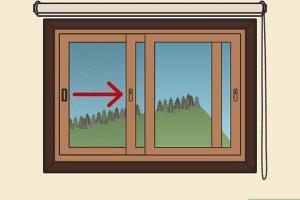How to Effortlessly Open a Window Screen: A Comprehensive Guide

-
Quick Links:
- Introduction
- Understanding Window Screens
- Types of Window Screens
- Tools Required
- Step-by-Step Guide to Opening a Window Screen
- Common Issues and Solutions
- Maintenance Tips for Window Screens
- Conclusion
- FAQs
Introduction
Window screens are essential for maintaining indoor air quality while keeping insects at bay. However, opening a window screen can sometimes be a challenge. This comprehensive guide will walk you through the process of opening various types of window screens, ensuring you can enjoy fresh air without hassle.
Understanding Window Screens
Window screens are typically made from materials like fiberglass, aluminum, or polyester mesh. They serve as a barrier, allowing air to flow while preventing bugs and debris from entering your home. Understanding how these screens are constructed will help you better navigate the opening process.
Types of Window Screens
There are several types of window screens, each with its own method for opening:
- Fixed Screens: These are non-removable and usually require the window to be opened to access.
- Retractable Screens: These screens can be pulled down or retracted into a housing unit when not in use.
- Sliding Screens: Mounted on a track, these screens slide horizontally to open.
- Magnetic Screens: These can be easily removed and replaced, often using magnetic strips for closure.
Tools Required
Opening a window screen may require some basic tools. Here’s a list of what you might need:
- Screwdriver (flathead or Phillips, depending on the fasteners)
- Utility knife (for stubborn screens)
- Measuring tape (if replacement is necessary)
- Cleaning cloth (for maintenance)
Step-by-Step Guide to Opening a Window Screen
Here’s a detailed, step-by-step guide on how to open different types of window screens:
Step 1: Assess the Type of Window Screen
Determine which type of window screen you are dealing with, as the method will differ based on construction.
Step 2: Prepare the Area
Clear any obstacles around the window for easy access. Make sure you have your tools ready.
Step 3: Open the Window
For fixed and sliding screens, you must first open the window. Ensure that it is fully opened to gain access to the screen.
Step 4: Removing Fixed Screens
- Locate the fasteners (screws or clips).
- Use the screwdriver to remove them carefully.
- Gently pull the screen away from the frame.
Step 5: Opening Retractable Screens
- Locate the handle on the side of the screen.
- Pull it downwards to extend the screen.
- Ensure the screen locks into place.
Step 6: Sliding Screens
- Gently slide the screen to the side until it clears the window frame.
- Be cautious of any debris that might obstruct movement.
Step 7: Magnetic Screens
- Simply pull apart the magnetic edges to open.
- Ensure to align the magnets again when closing.
Common Issues and Solutions
While opening window screens is typically straightforward, some common issues can arise:
Stuck Screens
If a screen is stuck, try gently wiggling it back and forth to disengage any debris lodged in the tracks.
Broken Fasteners
If you find a fastener is broken, you will need to replace it with a compatible one. Make sure to have spares on hand!
Weather-Related Issues
Extreme temperatures can cause screens to warp. In such cases, it may be necessary to replace the screen entirely.
Maintenance Tips for Window Screens
Proper maintenance can prolong the life of your window screens:
- Regularly clean screens with a soft cloth and mild soap.
- Inspect for tears or damages and repair promptly.
- Store retractable screens indoors during harsh weather conditions.
Conclusion
Opening a window screen doesn't have to be a daunting task. With this comprehensive guide, you can confidently open your window screens, improving ventilation in your home while keeping bugs at bay. Regular maintenance will ensure they remain functional for years to come.
FAQs
1. How do I open a window screen without damaging it?
Always use the appropriate tools and methods for the type of screen you have. Avoid forceful pulling.
2. Can I replace a damaged window screen myself?
Yes, replacement screens are available, and many can be installed with basic tools.
3. What type of screen is best for my home?
Consider your needs; retractable screens are great for versatility, while fixed screens are more durable.
4. How often should I clean my window screens?
At least twice a year, or more often if you live in a dusty area.
5. What materials are window screens made from?
Common materials include fiberglass, aluminum, and polyester mesh.
6. How can I tell if my screen is damaged?
Look for holes, tears, or warping that affects the screen's ability to seal.
7. Are magnetic screens effective?
Yes, they can be effective for keeping insects out while allowing easy access.
8. Can I paint my window screens?
Painting is not recommended as it can block airflow and cause peeling.
9. How do I store my window screens in winter?
Remove and store them in a dry place to prevent damage from ice or snow.
10. Can I install a window screen on any window?
Most windows can accommodate screens, but check dimensions and installation methods for your specific type.
Random Reads
- How to set different wallpapers on dual monitors
- Simple ways to adjust self closing spring hinges
- How to mount drives on linux
- How to move from windows to linux
- How to use your keyboard to make an angry face
- How to reset a ge dishwasher
- How to reset a ps3
- How to install vinyl flooring
- How to install vinyl gutters
- How to remove french keyboard